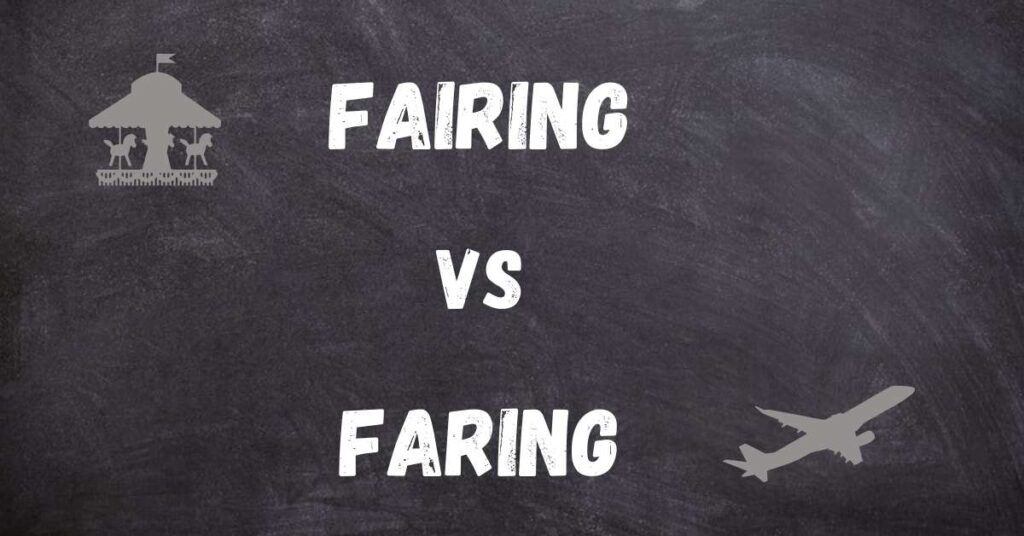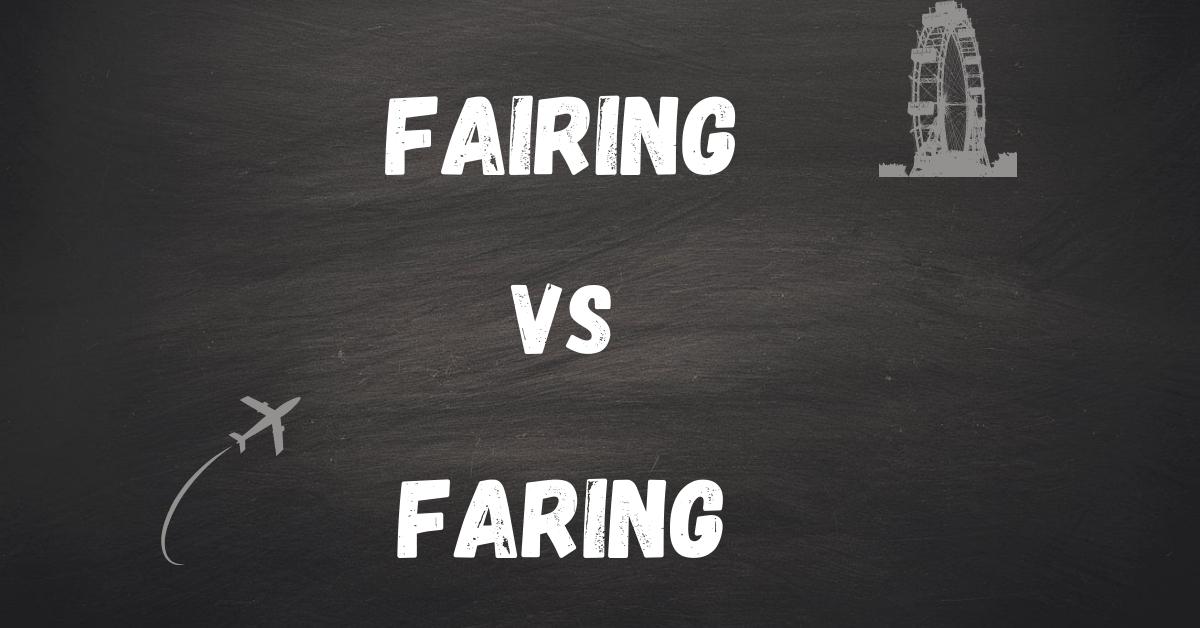Fairing vs Faring is a common point of confusion in the English language, as these two terms sound similar but have distinct meanings. Understanding the difference between them is essential for effective communication.
Fairing refers to a physical component that improves aerodynamics by reducing drag on vehicles like cars and aircraft, enhancing their performance. In contrast, faring relates to how someone is doing or managing in a particular situation, often reflecting their well-being and progress.
By exploring these definitions and their usage, we can clarify their meanings and improve our communication skills, ensuring we express ourselves accurately in both technical and personal contexts.
Quick Summary
Fairing refers to a physical component designed to improve aerodynamics by reducing drag on vehicles, while faring relates to how someone is doing or managing in a particular situation.
Recognizing this distinction can significantly enhance your communication skills. Misusing these terms can lead to confusion and misunderstandings, so it’s essential to grasp their meanings fully.
Understanding Fairing vs Faring

Confusion between fairing and faring often arises due to their similar sounds. However, the contexts in which they are used differ greatly. When discussing fairing, we typically refer to technical aspects related to design and engineering.
For example, engineers use fairings to streamline vehicles, making them more efficient by reducing resistance as they move through air or water. On the other hand, when we talk about faring, we engage in conversations about well-being or progress.
Asking someone “How are you faring?” is a way of inquiring about their current state or situation.
Contextual Understanding
Understand these terms, consider the contexts in which they are used. In technical discussions about vehicles or aircraft, you might hear phrases like “The fairing improved the vehicle’s efficiency.”
This highlights how fairing plays a vital role in aerodynamics. Conversely, in everyday conversations, you might ask a friend, “How are you faring with your new job?” Here, you’re expressing concern for their well-being and progress.
Origins of the Word Fairing
Fairing originated in the mid-19th century, specifically around 1865, referring to a piece added for streamlining purposes in engineering. It derives from the verb fair, which means to make something level or correct its shape, particularly in shipbuilding.
This verb comes from the Old English word “fæger,” meaning beautiful or pleasing to the sight. The connection to aesthetics emphasizes the importance of smooth, aerodynamic designs in vehicles, enhancing their performance by reducing drag and improving efficiency. Understanding this origin helps clarify the role of fairings in engineering and design
Fairing: Definition and Usage

Fairing is a structure designed to improve the aerodynamics of vehicles, such as cars, boats, and aircraft. By reducing drag, fairings enhance performance and fuel efficiency. They streamline shapes to allow smoother airflow, which is crucial in engineering and design.
Understanding how to use “fairing” correctly helps in technical discussions about vehicle design and performance.
Define Fairing
A fairing is defined as a structure designed to reduce drag on vehicles such as cars, boats, and aircraft. These components are crucial for improving aerodynamics and overall performance. In engineering terms, fairings help streamline shapes and minimize resistance during movement.
How To Use “Fairing” In A Sentence
When using “fairing” in a sentence, consider its technical context. For example, “The engineer designed a new fairing for the aircraft that significantly improved fuel efficiency.” This sentence illustrates how fairings play a vital role in enhancing vehicle performance.
Synonyms of Fairing
Here are some synonyms for fairing
- Cover
- Shroud
- Aerodynamic structure
- Casing
- Shell
- Enclosure
- Trim piece
- Fairlead
- Paneling
- Skin
These terms can enhance your vocabulary when discussing aerodynamics and vehicle design.
Faring: Definition and Usage

Faring refers to how someone is doing or managing in a particular situation. It often relates to well-being and progress in life. For example, when you ask, “How are you faring?” you are inquiring about someone’s current state or challenges.
Using “faring” correctly enhances communication by expressing concern for others and understanding their experiences.
Define Faring
Faring describes how a person is doing or managing in a specific situation. It relates to their well-being and progress, often reflecting their emotional state or ability to cope with challenges in different areas of life.
How To Use “Faring” In A Sentence
When using “faring” correctly in a sentence, you might say something like, “I hope you are faring well during these challenging times.” This shows concern for someone’s well-being while also emphasizing their ability to cope with difficulties.
10 Synonyms of Faring
Synonyms for faring include doing,
- Managing
- Progressing
- Thriving
- Coping
- Getting along
- Surviving
- Handling
- Succeeding
- Flourishing
These alternatives can help enhance your expression when discussing someone’s state or progress.
Side by Side Comparison
To clarify the differences between these two terms further:
| Aspect | Fairing | Faring |
| Definition | A structure designed to reduce drag | Refers to how someone is doing |
| Context | Technical discussions about vehicles | Personal inquiries about well-being |
| Example | “The fairing improved the aircraft’s efficiency.” | “How are you faring in your new job?” |
This table highlights key distinctions between fairing and faring, making it easier to remember their meanings.
Everyday Usage Examples

In everyday conversation or writing, using these words correctly enhances clarity. For instance:
When discussing fairing, one might say: “The new fairing design significantly reduced drag on the car.”
This statement emphasizes its technical application.Conversely, when talking about someone’s state: “I called her to see how she was faring after her surgery.” This shows concern for her recovery process.
Fairing Example
A fairing is an aerodynamic structure designed to reduce drag on vehicles. It enhances performance by streamlining shapes, improving efficiency in cars, boats, and aircraft during movement through air or water.
Examples Of Using Fairing In A Sentence
- The engineer designed a new fairing to enhance the aircraft’s performance.
- Installing a fairing on the motorcycle reduced wind resistance significantly.
- The boat’s fairing improved its speed and stability in rough waters.
- The team focused on optimizing the fairing for better fuel efficiency.
- Proper maintenance of the fairing is essential for safe operation.
Examples of Fairing in Context
The fairing on the racing car was crucial for achieving high speeds during the competition. Engineers discussed how the fairing design could influence overall vehicle performance in their presentation.
After testing, they found that the new fairing reduced drag by 20%. The fairing played a vital role in the aircraft’s aerodynamic efficiency. Designers often experiment with different fairing shapes to enhance functionality.
Faring Example

Faring refers to how someone is doing or managing in a situation. It encompasses well-being and progress, often used in inquiries about a person’s emotional state or life circumstances.
Examples Of Using Faring In A Sentence
- How are you faring with your new responsibilities at work?
- She is faring well despite the challenges she faces daily.
- I wondered how my friends were faring during their travels.
- He asked how I was faring after my recent surgery.
- The crops are faring better this year than last season.
Examples of Faring in Context
When I called, I asked my friend how she was faring after her move to a new city. The teacher wanted to know how her students were faring with remote learning. In our meeting, we discussed how everyone was faring with their projects and deadlines.
I often check in on my family to see how they are faring during tough times. The report detailed how the company was faring financially amid economic changes
Real Life Applications of Faring and Fairing

Understanding both terms has practical implications in daily life. For instance, using fairing correctly can be crucial when discussing engineering projects or vehicle designs. In contrast, using faring appropriately can enhance personal interactions by showing genuine concern for others’ well-being.
Exceptions To The Rules
Despite their distinct meanings, people often confuse these terms due to their similar sounds. It’s important to remember that while both words may appear interchangeable at first glance, they serve different purposes in communication.
Technical Terminology
In technical discussions about fairings, terms like aerodynamics and drag come into play frequently. Engineers focus on optimizing designs through various techniques such as streamlining shapes and minimizing resistance.
Regional Differences
Both words are understood across English-speaking regions, some areas may have unique expressions or preferences regarding usage. Being aware of these differences can improve communication skills.
Tips for Remembering the Difference

Remember the difference between fairing and faring, think of it this way: Fairings are physical components that help vehicles move better through air or water by reducing drag; meanwhile, faring relates to how someone is doing emotionally or situationally.
Associating each term with its context can aid retention.
Related Post: To Short or Too Short: What’s the Difference?
Common Mistakes to Avoid

Many people mistakenly use “faring” when they should use “fairing,” especially in technical discussions about vehicles or design elements. Conversely, others may use “fairing” when asking about someone’s well-being instead of using “faring.” Being mindful of these common errors can enhance clarity in communication.
Using Faring Instead Of Fairing
For example: Saying “The faring on my bike needs adjustment” instead of “The fairing on my bike needs adjustment” leads to confusion about whether you’re discussing a physical component or someone’s state.
Using Fairing Instead Of Faring
Another mistake occurs when someone says “How are you fairing?” instead of “How are you faring?” This misapplication can lead to misunderstandings regarding intent.
Incorrect Application in Sentences
Consider this incorrect sentence: “The faring helped my car go faster.” The correct form would be: “The fairing helped my car go faster.” Such errors highlight the importance of understanding each term’s meaning clearly.
Related post: Tomorrow or Tommorrow: What’s the Difference?
FAQs: Fairing vs Faring
Is it fairing or faring on?
The correct phrase is “How are you faring?” which inquires about someone’s well-being or progress, while “fairing” refers to a component that improves aerodynamics.
What does it mean to see faring?
To see “faring” means to understand how someone is managing or doing in a specific situation, often relating to their well-being or progress.
What does “faring” mean?
“Faring” refers to how well someone is doing or managing in a particular circumstance, indicating their level of success or well-being.
What is a fairing in slang?
In slang, “fairing” can refer to a gift or something given at a fair, but it primarily denotes an aerodynamic structure on vehicles.
Conclusion
Understanding the distinction between Fairing vs Faring is crucial for clear communication. While fairing pertains to components that enhance aerodynamics and vehicle performance, faring relates to an individual’s well-being and progress in various situations.
By using these terms accurately, you can avoid confusion and express yourself more effectively.
Whether discussing engineering concepts or checking on a friend’s situation, knowing when to use each term will enhance your communication skills and ensure your messages are clear and meaningful.

